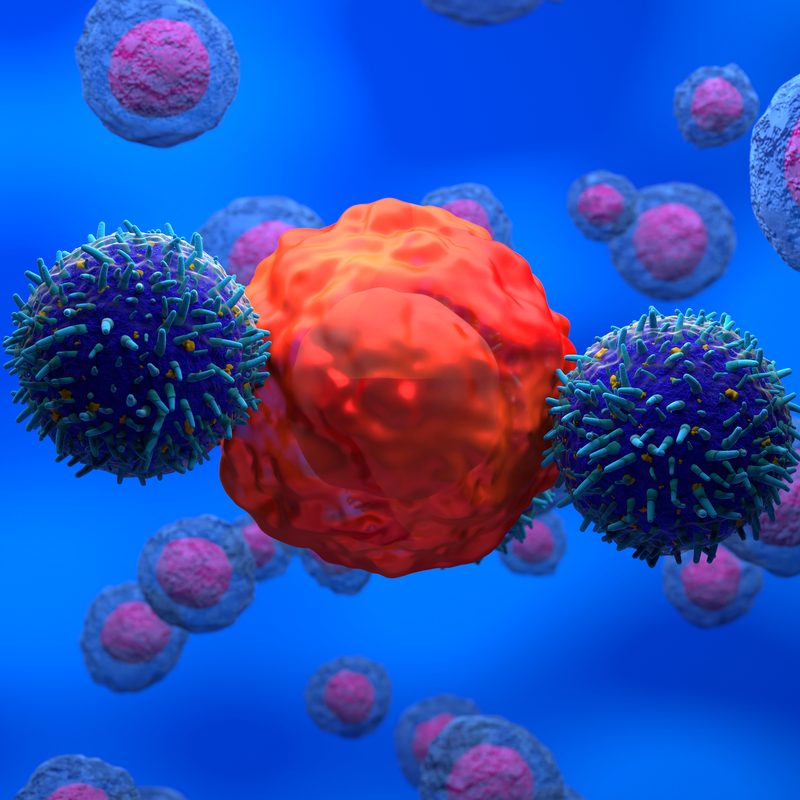
What is T-cell lymphoma?
T-cell lymphoma is the name given to a disease of the lymphatic system, which is abbreviated as T-NHL . T-cell lymphoma belongs to the group of non-Hodgkin lymphomas. In the disease, there is an accumulation of malignant T lymphocytes, called T cells, in the lymph nodes, but also in the liver, spleen and bone marrow. In some cases, T lymphocytes can also form in other organs . T lymphocytes belong to the white blood cells and fight off pathogens and foreign substances. T-cell lymphoma is a rather rare disease that usually occurs at an older age and starts with a malignant change in a single T-lymphocyte, which then multiplies over time.
What stages is T-cell lymphoma divided into?
According to the World Health Organisation (WHO) classification pathologists distinguish more than 20 types of T-NHL. The T-cell lymphomas are the largest subgroup of T-NHL and occur predominantly in the lymph nodes. They are also called nodal T-cell lymphomas . In addition, there are also the so-called mature T-cell leukaemias. These are a group of T-cell lymphomas that manifest themselves either predominantly in the blood or in various organs outside the lymph nodes. A further distinction is made between the so-called cutaneous T-cell lymphomas, which almost exclusively affect the skin. These are usually lymphomas of the mycosis fungoides subtype. There are also T-cell lymphomas that develop in the intestine or liver. They are called enteropathy-associated T-cell lymphomas, hepatosplendent T-cell lymphomas or extranodal NK-/T-cell lymphomas.
What are the symptoms of T-cell lymphoma?
In a T-cell lymphoma, a painless lymph node swelling may develop. This is due to the uncontrolled growth of the T cells. This can be accompanied by the following rather unspecific symptoms:
- Fever,
- Night sweats,
- unwanted weight loss,
- Fatigue and/or reduced performance,
- A tendency to severe and/or frequent infections
The
enlarged lymph nodes can also affect neighbouring organs
. If the bone marrow is affected, anaemia and
a reduction in white blood cells and/or platelets can be the result
. In almost one third of those affected, the organs outside
the lymphatic system are affected. Doctors refer to this as
extralymphatic involvement.
In this case, the symptoms are rather untypical for a lymphoma disease, which in some cases leads to a delay in the diagnosis of T-cell lymphoma.
How is T-cell lymphoma diagnosed?
A T-cell lymphoma is diagnosed by a biopsy. A tissue sample, for example from a lymph node, is taken from and examined by a pathologist. In order to determine the spread and stage of the tumour, it is also necessary to carry out further examinations . These include the usual imaging procedures. These include the usual imaging procedures of a magnetic resonance imaging (MRI) and a computer tomography (CT), which can be carried out in combination with a positron emission tomography (PET/CT) of the neck, chest, abdomen and pelvis, if necessary.
In most cases, a bone marrow puncture is necessary to check for bone marrow involvement. If the patient complains of neurological symptoms, a sample is taken from the neural fluid. In addition, extensive blood tests can be carried out in order to be able to make a statement about the disease activity, but also to be able to detect possible concomitant diseases at an early stage. To ensure the function of the organs , an ECG or an ultrasound of the heart should be carried out, for example. Based on all these examination results, an appropriate treatment is determined. This can vary in terms of type, duration and intensity .
How is T-cell lymphoma treated?
A T-cell lymphoma spreads rapidly, which is why therapy should be started as soon as possible after the diagnosis has been made . The respective form of treatment always depends on the stage of the disease, but also the course of the disease and other factors such as the general health of the patient. The following forms of therapy are possible:
- drug therapies: this usually involves chemotherapy, in which several substances can be administered if necessary. Doctors call this combination chemotherapy. Drug therapies are intended to interrupt the development and multiplication of the fast-growing lymphoma cells and help them to die.
- Radiation: In some cases of disease, it may be useful to have additional radiotherapy after chemotherapy.
- High-dose chemotherapy with stem cell transplantation: this is chemotherapy in a high-dose form and an autologous blood stem cell transplant, in which blood stem cells are removed and then put back into the blood. High-dose chemotherapy with stem cell transplantation can be used depending on the age of the person affected, the respective stage of the disease and the type of T-cell lymphoma.
What is the aftercare of a T-cell lymphoma?
After the therapy has been carried out, the patient should attend check-ups at regular intervals. In the first two years after the treatment, these follow-up examinations should be carried out at intervals of three months. After the third year, the check-ups can be done every six to twelve months .
During the follow-up examination, the doctor will perform a physical examination. However, blood is also taken from the patient in order to draw up a differential blood count . In addition, the liver and kidney values and, if necessary, the thyroid values are checked. If the patient complains of complaints, further examinations can be carried out, such as an ultrasound examination (sonography), a computer tomography (CT) and/or a PET/CT examination. If the corresponding indicators are present, a mirror examination may also be necessary.
